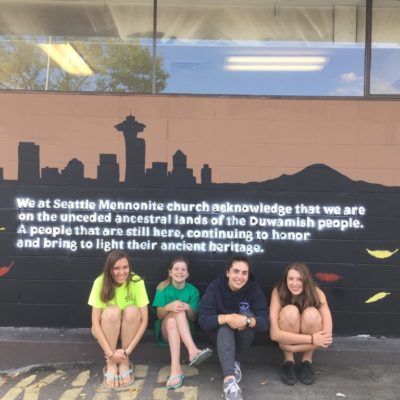By Olivia Smucker
When Thalia Neufeld needed a final project for !Explore, an Anabaptist-Mennonite Biblical Seminary theological program for high schoolers, she wanted to literally include her church.
Seattle Mennonite Church, where Neufeld is a member, works on homelessness in the Seattle community and advocates for the Duwamish people that first inhabited the land. For the project, Neufeld created a spray-painted mural on the side of the church building that emphasized the continued presence of the Duwamish and their relationship to the land that the church occupies.
Inspiration from conversation
The idea was originally proposed by Neufeld’s mother, Melanie Neufeld, who also serves the congregation as one of the pastors for community ministry and stewardship. From there, Neufeld met with one of the Duwamish elders, a woman named Edith Loyer Nelson, who worked with her to decide what kind of a statement should be presented in the mural. They decided that the message would “acknowledge the displacement” of the native people, as well as more publicly display Seattle Mennonite’s stance on dismantling the Doctrine of Discovery.
The Doctrine, which was created in the 15th century, was a document that gave Christian governments moral and legal rights to invade and claim Indigenous lands and dominate the people who first inhabited them. For some groups, like the Duwamish, the struggle for rights continues because the United States government fails to recognize them as a tribe, which limits the aid that they receive.
To maximize the impact of the mural, Neufeld decided that she would find a design online, then craft stencils to replicate the design on the wall with spray paint. After four months of preparation, it only took one day to paint and finish the piece. Her youth group and others from Seattle Mennonite helped.
Community recognition
Since its completion in the summer of 2018, the mural has sparked a lot of good conversations in the community about indigenous rights and thinking about the land the people of Seattle inhabit. Because the mural is on a wall next to a shared parking lot, people often spot it and comment when they come to church or visit the neighboring businesses.
Amy Epp, Seattle Mennonite’s pastor for discipleship and spiritual formation, has also been excited about what the mural means for the church. She said that this public statement is helping to externalize what the congregation was already feeling: being humbly open about their position supporting Indigenous rights.
A number of church members, as well as Seattle Mennonite itself, also contribute to Real Rent, a campaign by the Duwamish Solidarity Group. Real Rent encourages Seattleites to “pay rent” to the Duwamish for the land that they live on. This not only recognizes the Duwamish as the first owners of the land, but also helps to financially support the tribe. For more information about the campaign, visit https://www.realrentduwamish.org.
Acting as repairers
“We need to repair the breach between us and Indigenous People, as well as creation,” said Epp. “We have a lot to learn from First Peoples and their relationship with the earth.” Both she and Neufeld feel that Mennonites need to engage more with this. Since part of Anabaptist history is a story of persecution and removal from land, Anabaptists should also be sympathetic toward the plight of Indigenous People experiencing a similar situation.
“We don’t need to be defensive or guilty; we need to be repairers,” Epp said
Photo contributed by Thalia Neufeld (far right)
